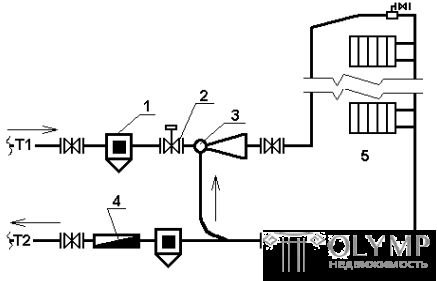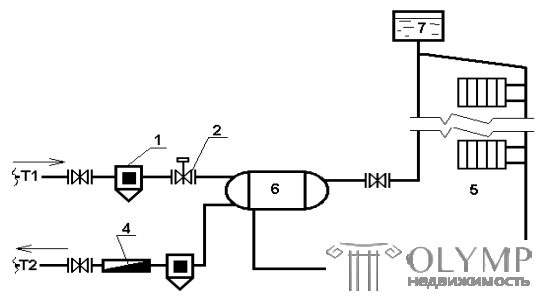
The choice of a heating system begins with the choice of a heat source, which may include district heating networks or its own heat source (boiler house), and is determined by local conditions. In the course project, the source of heat supply and the parameters of the coolant in it, as a rule, are given. For water heating systems, the recommended decision flow is shown in Fig. 2.1.
In addition to water, steam can be used in the heating system of the building being projected; it is possible to supply heated air into the room. Steam and air heating are of limited use and are allowed only in some public or industrial buildings [5, adj. ten].

Fig. 2.1. Recommended sequence for choosing a water heating system design
In water heating systems, the temperature of the supplied water is determined by the purpose of the building: the higher the sanitary and hygienic requirements for the indoor climate, the lower should be the temperature of the coolant. For example, in sports facilities, the limiting water temperature is 150 ° C, and in hospitals - 85 ° C. In residential buildings, the limiting coolant temperature is limited to 95 ° C for two-pipe heating systems and 105 ° C for single-pipe systems.
The effective standards [2] prescribe in public and administrative buildings, as a rule, to design single-pipe water heating systems with artificial induction of coolant circulation. But nowadays, in detached buildings, water heating systems from a house boiler house with natural circulation are often used.
In systems with artificial induction installed circulation pump. These systems require increased reliability of power supply, but less capital investment, since high water velocities and smaller pipe diameters are possible.
At low heights, two-pipe water heating systems are more often used, in other cases - single-pipe systems. One-pipe systems are easier to adjust and install; in two-pipe systems, water with a single temperature value flows into all devices, resulting in a smaller area of devices.
Connection of heating systems to heat networks is possible according to dependent (open, Fig. 2.2) and independent (closed, Fig. 2.3) heat supply schemes.
 |  | |
| Fig. 2.2. The heating unit of the heating system connected to the heating networks according to the dependent (open) scheme: 1 - sump; 2 - flow regulator; 3 - hydraulic elevator; 4 - flow meter; 5 - heating system | Fig. 2.3. Heat node in the heating system with natural circulation and closed heating circuit: 1–5 - see the notation in Fig. 2.2; 6 - water heater; 7 - expansion vessel |
In open schemes, the heating system is connected to the heat network through a hydraulic elevator (water jet pump). The elevator reduces the temperature of the supply water in front of the heating system from 130–150 ° С to 95–105 ° С by mixing chilled water from the return pipe of the heating system. For normal operation of the hydraulic elevator, the pressure difference in the supply and return pipelines of the heating system is not less than 0.08–0.15 MPa. Circulation of water in this heating system is carried out due to the pressure drop in the pipelines of the heating system. Such heating systems are simple and relatively cheap, but they create big problems in the operation of CHP and heating networks, since expensive, chemically purified water is lost in the systems.
As a result, insufficiently purified water has to be supplied to the heating network at the peak of the heating season, which leads to severe corrosion of pipelines and equipment. The use of such a system is possible only with favorable water quality.
The creation of a heat supply system according to an open scheme in the city of Khabarovsk was recognized as erroneous at the level of the Government of the Russian Federation, and measures for its reconstruction are provided.
In closed heat supply schemes, connection to the heating network is made with the help of a water heater. As a result, the heating system is hydraulically isolated from the heat network, the pressure in which does not affect the pressure in the heating system. Water losses in the heating system do not affect the fullness of the heating system. Such a connection is only possible for individual tall buildings in cases where the pressure in the heating network is insufficient to fill the heating appliances in the upper floors. In these systems, the water heater plays the role of the boiler. With a small length of such a system can be with natural circulation, with a large - with pumping. Water heaters, pumps and other equipment are installed in individual heat points (IHP) with heat supply of one building or in central ones (CTP) - with heat supply of several buildings.
Что бы оставить комментарий войдите
Комментарии (0)